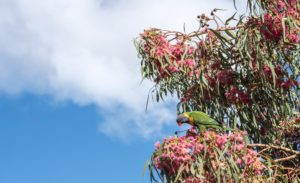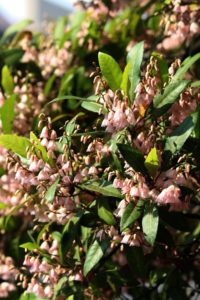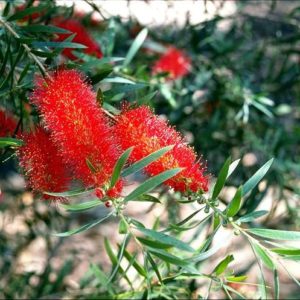The Greatest Small Evergreen Trees In Australia

Evergreen trees are those that retain their leaves and lush greenness all year-round. Trees of this kind also keep their shape and form and need little maintenance in terms of leaf litter clean-up. With spring in full swing, now is the perfect opportunity to update your garden, but what varieties are best if you have limited space? Here is our pick of the best small evergreen trees in Australia.
Flowering Gum (Corymbia Ficifolia)
Image from Shutterstock
Formerly known as Eucalyptus ficifolia, Corymbia ficifolia is one of around 80 eucalypts transferred in 1995 from the genus Eucalyptus to the newly created genus Corymbia. This red flowering gum is one of the most widely cultivated of all eucalypts in Australia.
It is moderately fast-growing in suitable climates, reaching 15 metres or more in height and two to five metres in width. It is best suited to temperate climates with low summer humidity and rainfall, however, it can be grown in subtropical areas in sunny, well-drained positions. Its bark is rough and doesn’t shed annually, and it has a dense canopy of large gum leaves and foliage that is a dark and glossy green.
The main drawcard of this species is its masses of brightly coloured flowers that bloom in spring. They come in a range of colours from vibrant oranges to pretty pinks and rich reds. The flowers are a favourite of bees and nectar-eating birds and are ideal for bringing wildlife into a landscape.
Blueberry Ash (Elaeocarpus R. Primadonna)
Image from Shutterstock
Also known as the native quandong, the Blueberry Ash is a stunning native rainforest tree with beautiful bronze coloured new growth and evergreen foliage. It grows four to five metres high and three metres in width and is low maintenance with high disease and pest resistance.
In spring, it produces a magnificent display of pale pink, bell-shaped flowers and its fruit is a sweet-scented blueberry. With its slender shape, it is ideal for feature planting or as a screening or avenue plant. It prefers a sunny position and is suited to the warmer parts of Australia or in protected areas in cooler climates. It should be planted in free-draining soil rich in organic matter.
Water Gum Plant (Tristaniopsis Luscious)
Image from Ozbreed
An improved version of the T. laurina, this evergreen features bronze or orange new growth, broad, deep and glossy green leaves, and decorative creamy grey bark. Growing to around seven to eight metres in height and five metres in width, its narrow habit and small yellow flowers contrast beautifully against dark backgrounds, so is ideal as a feature or screening plant.
When mature, it has a broad or oval column shape, and is also a neat tree, with minimal leaf drop. Regular fertilisers will produce neat, lush growth and aphids should be kept under control on new growth as it can diminish the plant’s appearance.
Griffith Pink (Brachychiton Populneus)
Image from The Tutu Guru
Growing to a height of around eight metres and a width of four metres, this evergreen is a pyramid-shaped tree with broad, pointed leaves in a zesty green shade. It has a large truck and leaves that are glossy and bright red when young, and when mature, foliage that creates a dense canopy.
In late spring, a festival of pink explodes when large clusters of densely packed bell-shaped flowers. Five centimetre-long seed pods will then appear after flowering. This is an adaptable tree that is frost and drought tolerant and adaptable to a wide range of soil types. It has low water requirements, should be mulched well and fertilised with a low phosphorus slow-release fertiliser.
Citrus (Rutaceae)
Image from Shutterstock
This is a genus of flowering shrubs and trees that is native to Australia and Asia. Plants in this genus produce citrus fruits including lemons, limes, oranges, mandarins, grapefruits, and kumquats. Depending on the type of citrus, height and width will vary but can range anywhere from two to eight metres.
However, although they are favoured for their productive qualities, there is nothing more aesthetically pleasing than a lush, well-shaped citrus tree. When in full bloom, they produce delicious, colourful fruit and add a beautiful perfume to the air.
Citrus trees prefer free-draining soils that are neutral to acidic. Because they are shallow-rooted trees, they will also require regular watering and benefit from a thick layer of organic mulch.
Little Gem (Magnolia Grandiflora)
Image from Shutterstock
A dwarf variety of Magnolia grandiflora, it will only reach around four to five metres in height and three metres in width. However, it has the same glossy green foliage, a dense growth habitat and a rich reddish-brown under-leaf. In spring and summer, it will also produce large white fragrant flowers.
‘Little Gem’ will grow well in most parts of Australia, and is a robust plant that can handle frosts, high winds and moderate drought. However, it requires well-drained soil and a position in part-shade or full sun. The roots should be kept moist and cool with mulch, and in prolonged dry periods be given a deep soaking. Seed heads should be removed after flowering to encourage new growth and more flowers. It is ideal for screens, hedges, in garden beds or in large decorative patio pots.
Magnolia Kay Parris
Image from The Plant Store
As mentioned above, magnolias are a magnificent example of an evergreen that has striking foliage, beautiful flowers and a sweet perfume. This variety has beautifully dense foliage with small, dark glossy leaves that have a velvety brown underside. It can grow to a width of three metres and a height of around four.
It produces pearly white flowers during the warmer months from November through to March that are much larger than the Little Gem variety.
This plant exhibits bright pink new growth, a wavy edge to its leaves and makes for a perfect feature tree or evergreen screen. It prefers rich, deep soil and should be watered well with liquid fertiliser and mulched to maintain cool roots. When young, the plant should be staked to allow for an upright habit to form.
Wollemi Pine (Wollemia Nobilis)
Image from Shutterstock
Wollemia nobilis is a conifer in the plant family, Araucariaceae, and its discovery in 1994 was met with excitement by the botanical community because of its resemblance to conifer fossils like Agathis jurassica and Dillwynites.
It is a striking tree that has elegant feathery foliage that is bright green before it matures to a dark jungle green colour. It can grow up to 40 metres in the wild, so it is recommended that in small gardens it be grown in a large pot. In this instance, it will grow to five to eight metres in width and upwards of 10 metres in height.
The tree’s bark is chocolate brown in colour and bubbly in appearance, and it has cones that appear at the end of branches. It also has two types of branches — one that grows laterally and bears sessile leaves, and another that grows upright so that it looks like a trunk is arising from the base of the tree.
This evergreen is tough and adaptable, however, gales, frost and heat can burn saplings, so a temporary windbreak and sun protection is recommended. Potted plants should never be kept in sauces of water as the roots can rot, and for maximum growth, re-pot them every spring. If cared for properly, they can transform a landscape as an extraordinary feature plant.
Peppermint tree (Agonis Flexuosa)
Image from Shutterstock
This medium-sized evergreen grows from three to five metres in height and seven to 10 metres in width and has pinkish new growth. When mature, it has a bold branching character and stout trunk.
It has dense, aromatic medium green foliage that is aromatic, and its long narrow leaves hang gracefully from drooping branches that release a spicy peppermint fragrance when crushed. Branches and trunks are covered with distinctive and coarse red-brown bark, and small brilliant white flowers occur in spring.
Peppermint trees may need staking when young, but these should be removed as early as appropriate to allow the plant to develop its strength. Keep them well drained otherwise they can suffer from root rot. Enrich soil with organic matter, and resist the urge to trim them as they look their best with natural development.
This tree can be used for screening or a windbreak, and it is highly valued as a shade tree where it provides hanging foliage that resembles a weeping willow.
Ornamental Pear – Pyrus Calleryana
Image from The Tutu Guru
This evergreen comes in varieties like the Capital Pear (which is upright and column-shaped) and the more traditional Manchurian (which is pyramid-shaped). It can grow to a height of eight metres and a width of three metres, and often has a conical crown.
Flowers are white and produced abundantly in early spring before the leaves expand fully. The glossy dark green leaves hang vertically from branches, and because of their long stems, they often flash their slightly paler undersides in a breeze. In autumn, its leaves commonly turn brilliant colours — from orange and yellow to pink, red, bronze and purple.
It prefers a full sun position, and although drought hardy, should be watered over the warmer months until the tree is established. A slow-release, general purpose fertiliser can be used in autumn and spring. This tree is ideal as a screening plant or garden feature.
Evergreen Ash (Fraxinus Griffithii)
Image from Shutterstock
Evergreen Ash is a small, delightfully shady tree that’s perfect for smaller gardens as a feature tree or amidst other trees. It has a rounded form and is fast-growing, and will typically reach a height of around seven metres and four metres in width.
Its leaves are oval-shaped with pointy tips and are green and glossy on top and silver coloured underneath. It produces an abundance of white flowers in spring, and is a relatively hardy tree, tolerating mild drought conditions and wind exposure. However, it does perform best in moist, well-drained soils with full sun, and may need to be watered in extended dry periods.
Cottonwood (Hibiscus Tiliaceus Rubra)
Image from Gardens Online
This is a popular, fast-growing plant from tropical Queensland. It is a rounded medium-sized tree and can grow to a height of around five metres and width of three and a half metres. In spring it produces beautiful yellow flowers that will attract birds to your garden.
Being an Australian native, it is low maintenance, extremely hardy and will tolerate Australia’s often-harsh weather conditions. It only requires moderate watering (particularly if exposed to windy sites), and should be pruned after flowering and fertilized in spring. It is commonly used as a hedge, a dense screening tree, or as a feature or shade tree.
Callistemon Kings Park Special
Image from Australian Plants Online
This is a fast-growing bottlebrush that can quickly reach five metres in height and three to four metres in width. It has attractive furrowed bark, and in spring and autumn, its bright red flowers will attract lots of birds, butterflies and pollinating insects.
It is tolerant of many soil types and can even grow in clay and sandy soils, however, soil should be conditioned with compost to ensure new growth. This plant is ideal as a screen or feature plant and can be allowed to grow naturally or pruned to shape.
References
- 2019, Best Evergreen Trees of 2020, Kilby Park Tree Farm
- Annette Tickenoff, 2014, Evergreen Trees for Smaller Urban Gardens, Lakeside Nursery



















